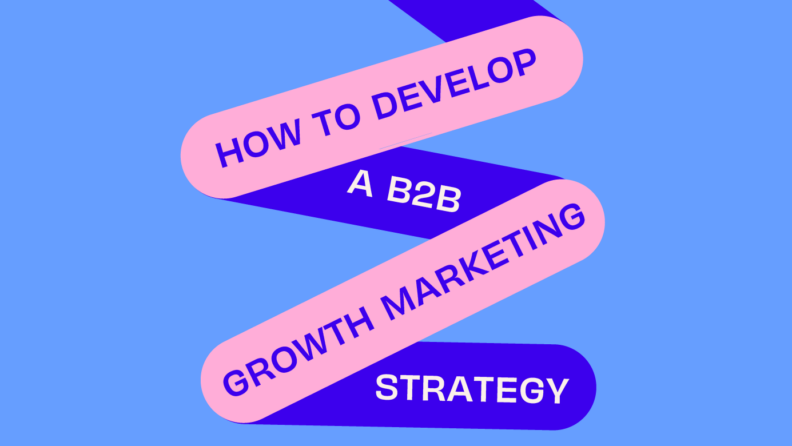Everyone knows that sales and marketing are incredibly important when building a business. In fact, 87% of sales and marketing leaders acknowledge collaboration between them enables critical business growth. With a dynamic so vital, it’s important to understand the myriad ways that one can help the other—and vice versa—so that your business can reach its full potential. That all comes down to how well planned your growth marketing strategy is.
As a professional with years of experience developing and actioning growth marketing strategies for small to medium sized companies, I’m here to help you understand the steps involved in creating one that’s successful. By the end of this article, you’ll have everything you need to take your b2b sales to the next level!
What is B2B Growth Marketing?
B2B growth marketing is a dynamic approach that focuses on driving business growth by aligning marketing strategies with sales and revenue objectives. Unlike traditional marketing, which primarily targets consumer audiences, B2B growth marketing caters to the unique needs and complexities of businesses, nurturing long-term relationships and maximizing revenue potential.
TLDR; Marketing and sales objectives become one.
How to Develop a B2B Growth Strategy
1. Set Clear Goals and Objectives
First and foremost, what do you want to accomplish? You need to identify your b2b marketing objectives and growth targets so you can make sure the marketing plan is perfectly aligned with the overall vision.
Round up your key stakeholders (you know, the really important people in the nice offices on the top floor) and get to know them like the back of your hand. By involving them in the goal-setting process, you can tailor your strategy to meet their every need and build high-quality partnerships in the process. They’ll also give you crucial insight on what KPIs you should be measuring. Those will measure your progress and tell you if you deserve a Happy Hour on Thursday afternoon… or if you’ll be reworking strategy on Friday morning.
2. Conduct Market Research
Step two: conducting proper market research. You’ll need to identify your target market segments and dig deep into the data to create buyer personas. You want to understand your potential customers inside out so you can serve them up the perfect solution along with top of the line customer experience.
Analyzing competitors and market trends is also crucial for gaining a competitive edge. Study the strategies and strengths of other b2b companies while keeping a finger on the pulse of emerging trends. Incorporating firmographics and technographics deepens your understanding of your target market, enabling you to segment your audience effectively.
Firmographics are the nitty-gritty details about customers' businesses—their size, industry, location, and more. It's like getting a backstage pass to their company's inner workings. And technographics? Well, that's where we tap into their technological preferences, the tools they use, and the digital landscape they navigate. It's like peeking into their digital DNA.
It should almost feel like you know your new customers and their pain points too well. Like, you know which house they went to last Thanksgiving and whose in-laws are the problematic ones.
3. Craft a Compelling Value Proposition
So you understand your desired customers, that’s great! But what’s going to make them choose you over their other option? This is where your value proposition comes in clutch. You’ve got to define your unique selling points and competitive advantages that make your product stand out like a hot pink flamingo in a flock of grey b2b businesses.
Communicate the benefits and advantages of your offerings using persuasive language. From a new piece of content to sales presentations, sprinkle in your value proposition everywhere you go. With a compelling value proposition, you may just break the internet on launch day!
4. Create an Effective Marketing Funnel
There's a few crucial steps when creating a marketing funnel that is a pro at lead generation and lead nurturing. First stop: awareness. Hit them with content marketing, social media campaigns, and aim to be on the first page of their relevant search engine, the digital version of a huge highway billboard.
Next up: consideration. This is where you provide valuable content, case studies, and testimonials that make your customers stop and think, “Huh, these people may know their stuff!” This will build trust in you, your company, and most importantly, your product.
Finally, the decision stage. You’ll highlight your unique value proposition, the one you’ve 100% mastered by now, and offer incentives a consumer can't resist. Personalized consultations, free trials, you name it. Oh, and don't forget, data is your best friend here. Track and analyze metrics like click-through rates and conversions to fine-tune future marketing strategies.
5. Leverage Digital Marketing Channels
There's a whole arsenal of strategies and social media management tools at your disposal, like the “It Girls” of marketing (can you tell this is my favorite part?). There’s content marketing and thought leadership, where you create content that establishes you as the industry leader and builds brand awareness. Then, the dynamic duo of SEO and SEM take over to optimize content and get your paid ad campaigns in front of the right eyes. Email marketing and automation work together to get customer’s swooning over personalized communication from the company.
Social media marketing and influencer partnerships are the talk of the town nowadays and you’d be remiss to leave them on the table. Consider publishing on Facebook, Instagram, TikTok, LinkedIn, and Twitter, but remember to go where your audience is, and that it’s better to do a few platforms well than to spread yourself too thin. You’ll engage with your customer base directly, and through individuals that they already have an established trust with.
When you’re evaluating all of these different channels, be sure to think about the buyer’s journey and match the marketing efforts to the different stages of awareness, consideration, and decision-making. And of course, consider your goals, budget, and those pesky (but necessary) KIPs. You want to be smart about where you invest your energy.
6. Measure and Analyze Results
Everyone is obsessed with data, and for good reason. Define the relevant metrics that will give you an in-depth look at your performance. Think back to the beginning where we talked about your objectives and KPIs. You could look at website traffic, conversion rates, customer acquisition cost, retention rates, or engagement on social media.
Once the metrics are locked in, it's time to bring in the big guns: analytics tools and dashboards. They’ll crunch the numbers, slice and dice the data, and give you the insights the team will need to make informed decisions. The reports and charts will be available to paint a clear picture of what's working and what's not. But don’t just look at it, iterate and optimize marketing efforts based on the insights. If something's not working, pivot! If you spot a golden opportunity, snag it!
7. Sales and Marketing Collaboration
As we established at the beginning of this article, when the marketing team and sales team join forces, amazing things happen. Grab your key stakeholders and make sure your sales and marketing goals are aligned. Messaging, targeting, and overall approach need to be 100% on the same page so you can tackle the market together.
Regular communication and feedback loops are key to keeping the collaboration alive and kicking. Have weekly meetings, share insights, and exchange high-fives. It's all about open dialogue and a constant flow of information. Utilize marketing software and CRM systems that make collaboration seamless! Salesforce is a great resource for this. You should create a centralized hub where the team will share leads, inbound activity, track their progress, and stay updated on the latest developments. Collaboration is the name of the game to drive growth.
8. Test and Experiment
Not with test tubes though, A/B testing and conversion rate optimization. It's like being a mad scientist in the marketing lab. Create different versions of campaigns, landing pages, or emails, and put them to the test. The team can see what makes your target audience click the magical "buy" button.
When you’ve gathered results, implement iterative improvements to your b2b marketing strategy. Take the insights and make tweaks, enhancements, and upgrades to your strategy. But it's not just about the tests themselves; it's about embracing a culture of experimentation and continuous learning. The marketing “lab” should foster an environment where trying new things and taking calculated risks is celebrated. Learn from your successes and grow from your failures!
9. Adapt to Changing Market Conditions
Now that you’ve done all this work, don’t let it go to waste by thinking you get to stop here. Keep an eye on market trends and industry shifts. Monitor the pulse of the market, stay up to date on emerging b2b marketing trends, and be ready to pivot at a moment's notice. LinkedIn is a great resource for this! Follow creators and professionals that you admire.
Being agile is a superpower. Adjust your strategies, tweak the messaging, and realign targeting to stay ahead of the curve. And don’t forget to look for new technologies to take advantage of like AI and marketing automation, new social media platforms, or innovative management tools. Staying stagnant is not an option when it comes to growth marketing!
What now?
With the right approach, a dynamic B2B marketing strategy can work for small businesses and large enterprises alike. If a specific step of this round up of b2b growth marketing strategies tickled your fancy, shout it out below!
To stay ahead of the trends, check out this awesome post on how CMOs are using AI in marketing and be sure to subscribe to The CMO newsletter.



